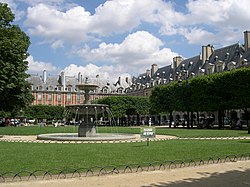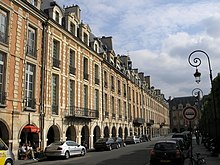Place des Vosges
| Place des Vosges | |
|---|---|
| location | |

|
|
| Arrondissement | 3rd , 4th |
| quarter | Marais |
| morphology | |
| shape | rectangular |
| length | 140 m |
| width | 140 m |
| surface | 12370 m² (garden in the middle) |
| history | |
| Emergence | 17th century |
| Original names | Place Royale place des Fédérés Place du Parc-d'Artillerie Place de la Fabrication-des-Armes place de l'Indivisibilité Place de la République |
| Classification | |
| Coding | |
| Paris | 9882 |
The Place des Vosges (dt .: "Place of the Vosges "; [ plas de voʒ ]) is a Parisian district of Marais ( 3rd and 4th arrondissement ) situated place . It is the oldest of the five “Royal Squares” (followed by Place Dauphine ) and is considered one of the most beautiful squares in Paris. The square square has the dimensions of approx. 140 × 140 meters and was designed by Louis Métezeau . It forms a closed square, which is connected on one side by a main road, while two bridge houses provide access on the opposite side. - It is considered to be the «template» of the Place Ducale in Charleville-Mézières .
Name origin
The current name, Vosges Square, was first given in 1800. It was so named because the Vosges department was the first to fully pay the revolutionary tax levied at the time. The first national volunteers from the Remiremont district also came to defend the endangered country.
After the return of the Bourbons in 1814/15 and again from 1852 to 1870, the square was given its original name, but from September 16, 1870 it was finally called Place des Vosges .
Names of the place through the centuries:
- July 1605: Place Royale ("Place Royalle")
- August 19, 1792: Place des Fédérés
- 4th July 1793: Place de l'Indivisibilité
- 1793: Place du Parc-d'Artillerie
- 1793: Place de la Fabrication des Armes
- September 13, 1800: Place des Vosges
- April 27, 1814: Place Royale
- 1830: Place de la République
- March 14, 1848: Place des Vosges
- 1852: Place Royale
- September 16, 1870: Place des Vosges
history

The square was built as Place Royalle ( sic ) in the years 1605 to 1612 at the express order of the French King Henry IV and was the first urban square in Paris. On the occasion of the double wedding of King Ludwig XIII. with Anna of Austria (1601–1666) and the king's sister, Elisabeth, with the future King Philip IV of Spain, it was inaugurated between April 5 and 7, 1612 with extraordinarily solemn tournaments. Client Heinrich IV did not live to see the inauguration because he was assassinated on May 16, 1610. The marriage contract was signed shortly after the inauguration on August 25, 1612.
role models
Bastids
While market squares and church squares are part of the historical cityscape in many European countries, such facilities are rarely found in northern France - the cities were usually very densely built up. Exceptions, however, are the rectangular plazas lined with arcades in the heart of the bastides built in the late 12th and especially in the 13th century in many areas of Occitania , where the church is usually not in the center but in a side street. Before his coronation, Henry IV stayed several times with a friend in Labastide-d'Armagnac , from whose house he had a view of the completely regularly laid out square with a central fountain; It is speculated that this ultimately inspired him to build the Place Royale later.
Plaza Mayor in Madrid
The Spanish ruler Philip II moved the royal court from Valladolid to Madrid in 1561 and had the Plaza Mayor built there from 1580/90 , which was completed by 1619 - as a partially six-storey complex and with arcades on the ground floor. It is quite likely that Henry IV was aware of his southern neighbor's building project. Only after several fires were all the houses in the Plaza Mayor limited in height to four storeys towards the end of the 18th century.
architecture
The basis of the square design of the Place Royale was a royal pavilion, which was built at the south end of the square in 1604 by the Baptist Jean Androuet du Cerceau . All other 35 buildings - with the exception of the slightly higher Pavillon du Roi and the Pavillon de la Reine - were to follow the same design. For the first time in Europe, three-story houses with arcades on the ground floor were built on all sides of a square - on the basis of uniform planning. These 36 city palaces all stand on the eaves to the center of the square and were designed with red brick facades in the colored effect of the “Brique-et-pierre facades”, which ultimately follow the ancient Roman tradition. The high pitched roofs are loosened up by dormer windows . Due to the development at the side, windows could only be installed on the front and rear of the houses. The responsible architects are Claude Chastillon and Louis Métezeau . The concept of continuous arcades on the ground floor, which was realized here for the first time in France - apart from the medieval bastides - later served as a model for the design of numerous squares and streets throughout Europe. A prime example in Paris is the Rue de Rivoli designed by Napoleon I , which runs just a little south of the square.
use
Heinrich IV wanted his place - and in this respect quite comparable to the bastides - a mixed form of use: craft businesses or factories on the ground floor, apartments above. But the first buyers of apartments or entire houses within the complex were members of the nobility, who eventually also occupied the entire complex. Traders rented themselves behind the arcades on the ground floor, who provided the noble lords with everything they needed.
Equestrian statue
The small park (12,370 m²) in the middle of the square was established in 1866. In the middle of the square is an equestrian statue of King Louis XIII. , the son and successor of Henry IV. The first bronze statue from 1639 was destroyed during the French Revolution . The current one, dating from 1829, is made of stone and is by the sculptors Jean-Pierre Cortot and Louis Dupaty .
Prominent residents
- In the house no. 1a was Madame de Sevigne was born on February 6, 1626 when Marie de Rabutin-Chantal. She lived here until she was 10 in 1636. At the age of 17 she married the Marquis Henri de Sévigné . She became world famous through her correspondence with her daughter, Françoise Marguerite de Grignan , in which she described life at the court of Louis XIV in detail for over 25 years .
- The . House No. 21 was - according to some sources - from late 1622 to 1625 by Cardinal Richelieu inhabited. The writer Alphonse Daudet is said to have lived in the courtyard of the house in 1877 .
- The second floor of house number 6 ( Hôtel Guéménée ) was occupied by the writer Victor Hugo from 1832 to 1848 . On June 30, 1903, the Maison de Victor Hugo museum, dedicated to him and his work, was opened in this house .
- The second floor of house number 8 was occupied by the writer Théophile Gautier from 1828 to 1834 . The writer Alphonse Daudet later moved in here.
- In 2011, the politician Dominique Strauss-Kahn lived in house No. 13 with his wife Anne Sinclair .
Others
Around the same time as the Place des Vosges, the rectangular Place Ducale was built in Charleville . Both plazas are very similar, which is primarily due to the fact that two of the architects responsible were brothers. In addition, the principal of the Place Ducale, Charles de Gonzague , was a nephew of Henry IV and Duke of Nevers and Rethel .
See also
The rest of the royal squares of Paris are:
- Place Dauphine , built 1607–1612
- Place des Victoires , built in 1675
- Place Vendôme , built from 1688
- Place de la Concorde , built from 1755
literature
- Julia Droste-Hennings, Thorsten Droste : Paris . DuMont Verlag 2003, ISBN 3-7701-6090-8 , pp. 142-144.
- Alexandre Gady and others: De la Place Royale à la Place des Vosges. Paris 1996.
- Andreas Köstler: Place Royale. Metamorphoses of a critical form of absolutism . Wilhelm Fink Verlag, Munich 2003, ISBN 3-7705-3772-6 .
- Wolfgang Braunfels : Occidental city architecture. Form of rule and structure. Cologne 1976, ISBN 3-7701-0882-5 .
- Heinz Coubier: European city squares. Genius and history. DuMont, Cologne 1985, ISBN 3-7701-1266-0 , pp. 207f.
- Fritz Stahl: Paris. A city as a work of art . Rudolf Mosse Buchverlag, Berlin 1929.
Web links
Coordinates: 48 ° 51 ′ 20 " N , 2 ° 21 ′ 56" E






